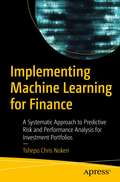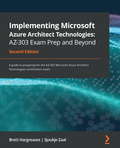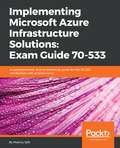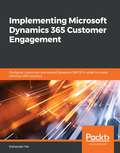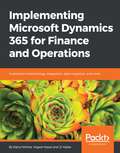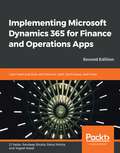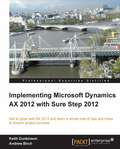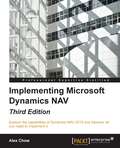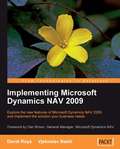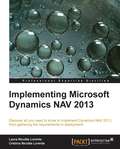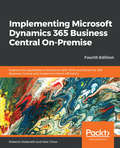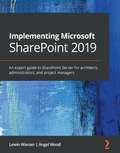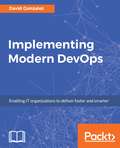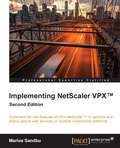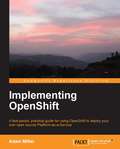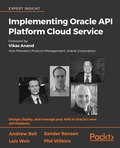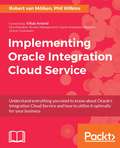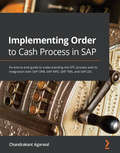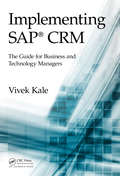- Table View
- List View
Implementing Machine Learning for Finance: A Systematic Approach to Predictive Risk and Performance Analysis for Investment Portfolios
by Tshepo Chris NokeriBring together machine learning (ML) and deep learning (DL) in financial trading, with an emphasis on investment management. This book explains systematic approaches to investment portfolio management, risk analysis, and performance analysis, including predictive analytics using data science procedures.The book introduces pattern recognition and future price forecasting that exerts effects on time series analysis models, such as the Autoregressive Integrated Moving Average (ARIMA) model, Seasonal ARIMA (SARIMA) model, and Additive model, and it covers the Least Squares model and the Long Short-Term Memory (LSTM) model. It presents hidden pattern recognition and market regime prediction applying the Gaussian Hidden Markov Model. The book covers the practical application of the K-Means model in stock clustering. It establishes the practical application of the Variance-Covariance method and Simulation method (using Monte Carlo Simulation) for value at risk estimation. It also includes market direction classification using both the Logistic classifier and the Multilayer Perceptron classifier. Finally, the book presents performance and risk analysis for investment portfolios.By the end of this book, you should be able to explain how algorithmic trading works and its practical application in the real world, and know how to apply supervised and unsupervised ML and DL models to bolster investment decision making and implement and optimize investment strategies and systems.What You Will LearnUnderstand the fundamentals of the financial market and algorithmic trading, as well as supervised and unsupervised learning models that are appropriate for systematic investment portfolio managementKnow the concepts of feature engineering, data visualization, and hyperparameter optimizationDesign, build, and test supervised and unsupervised ML and DL modelsDiscover seasonality, trends, and market regimes, simulating a change in the market and investment strategy problems and predicting market direction and pricesStructure and optimize an investment portfolio with preeminent asset classes and measure the underlying riskWho This Book Is ForBeginning and intermediate data scientists, machine learning engineers, business executives, and finance professionals (such as investment analysts and traders)
Implementing Microsoft Azure Architect Technologies: AZ-303 Exam Prep and Beyond
by Brett HargreavesThis book is for solution architects and experienced developers who advise stakeholders and translate business requirements into secure, scalable, and reliable solutions. Technical architects interested in learning more about designing cloud solutions will also find this book useful. Prior experience and knowledge of various aspects of IT operations, including networking, security, business continuity, disaster recovery, budgeting, and governance, will assist with understanding the concepts covered in the book.
Implementing Microsoft Azure Infrastructure Solutions: A comprehensive, end-to-end study guide for the 70-533 certification with practice tests
by Melony QinDevelop skills and knowledge for provisioning and managing services in Microsoft Azure and implement infrastructure componentsKey FeaturesBuild and manage robust infrastructure solutions on Microsoft AzurePlan and implement Azure storage, backup, and recovery servicesPrepare and boost your confidence with certification-based mock tests and solutionsBook DescriptionMicrosoft Azure is a prominent public cloud provider, recording the highest user base growth in the year 2017. Microsoft has prominent certifications that help architects, developers, and administrators gain hands-on knowledge while working on Azure. 70-533 is one such advanced-level certification, which deals with infrastructure solutions on Microsoft Azure.Implementing Microsoft Azure Infrastructure Solutions starts with an overview of the certification and an introduction to Microsoft Azure. Next, you will learn how to plan and implement virtual machines and containers, followed by designing and implementing service apps. As you make your way through the chapters, you will learn how to implement and manage virtual networks and Azure identities, as well as the Active Directory infrastructure in a hybrid environment. In the concluding chapters, you will learn how to plan and implement storage and security, and business continuity and disaster recovery (BCDR) strategies. You will also automate and monitor cloud management operations in Azure. By the end of the book, you will have covered all of the modules, along with the practice questions at the end of each chapter, which will be extremely helpful in passing the 70-533 certification exam.What you will learnExplore cloud basics and gain an overview of Microsoft AzurePlan and implement virtual machines and containers for scalability and resilienceUnderstand virtual networks' cross-premises connectivityLearn how to manage your Azure identitiesPlan and implement storage, security, and the BCDR strategyAutomate and monitor cloud management operations in AzureManage app services for resilience and availabilityInteracting with Azure Services by using ARM, the Azure CLI, and PowerShellWho this book is forImplementing Microsoft Azure Infrastructure Solutions is for senior cloud professionals who already have experience working with the Azure ecosystem and want to take their knowledge to the next level. Prior knowledge of the Azure ecosystem is necessary.
Implementing Microsoft Dynamics 365 Customer Engagement: Configure, customize, and extend Dynamics 365 CE in order to create effective CRM solutions
by Mahender PalGain hands-on experience working with the architecture, implementation, deployment, and data migration of Dynamics 365 Customer Engagement Key Features Explore different tools to evaluate, implement, and proactively maintain Dynamics 365 for CE Integrate Dynamics 365 CE with applications such as Power BI, PowerApps, and Microsoft Power Automate Design application architecture, explore deployment choices, and perform data migration Book Description Microsoft Dynamics 365 for Customer Engagement (CE) is one of the leading customer relationship management (CRM) solutions that help companies to effectively communicate with their customers and allows them to transform their marketing strategies. Complete with detailed explanations of the essential concepts and practical examples, this book will guide you through the entire life cycle of implementing Dynamics 365 CE for your organization or clients, and will help you avoid common pitfalls while increasing efficiency at every stage of the project. Starting with the foundational concepts, the book will gradually introduce you to Microsoft Dynamics 365 features, plans, and products. You'll learn various implementation strategies and requirement gathering techniques, and then design the application architecture by converting your requirements into technical and functional designs. As you advance, you'll learn how to configure your CRM system to meet your organizational needs, customize Dynamics 365 CE, and extend its capabilities by writing client-side and server-side code. Finally, you'll integrate Dynamics 365 CE with other applications and explore its business intelligence capabilities. By the end of this Microsoft Dynamics 365 book, you'll have gained an in-depth understanding of all the key components necessary for successful Dynamics 365 CE implementation. What you will learn Explore the new features of Microsoft Dynamics 365 CE Understand various project management methodologies, such as Agile, Waterfall, and DevOps Customize Dynamics 365 CE to meet your business requirements Integrate Dynamics 365 with other applications, such as PowerApps, Power Automate, and Power BI Convert client requirements into functional designs Extend Dynamics 365 functionality using web resources, custom logic, and client-side and server-side code Discover different techniques for writing and executing test cases Understand various data migration options to import data from legacy systems Who this book is for This book is for consultants, project managers, administrators, and solution architects who want to set up Microsoft Dynamics 365 Customer Engagement in their business. Although not necessary, basic knowledge of Dynamics 365 will help you get the most out of this book.
Implementing Microsoft Dynamics 365 for Finance and Operations
by Yogesh Kasat Jj Yadav Rahul MohtaHarness the power of Dynamics 365 Operations and discover all you need to implement it About This Book • Master all the necessary tools and resources to evaluate Dynamics 365 for Operations, implement it, and proactively maintain it. • Troubleshoot your problems effectively with your Dynamics 365 partner • Learn about architecture, deployment choices, integration, configuration and data migration, development, testing, reporting and BI, support, upgrading, and more. Who This Book Is For This book is for technology leaders, project managers solution architects, and consultants who are planning to implement, are in the process of implementing, or are currently upgrading to Dynamics 365 for Operations. This book will help you effectively learn and implement Dynamics 365 for Operations. What You Will Learn • Learn about Microsoft Dynamics 365, it's offerings, plans and details of Finance and Operations, Enterprise edition • Understand the methodology and the tool, architecture, and deployment options • Effectively plan and manage configurations and data migration, functional design, and technical design • Understand integration frameworks, development concepts, best practices, and recommendations while developing new solutions • Learn how to leverage intelligence and analytics through Power BI, machine learning, IOT, and Cortana intelligence • Master testing, training, going live, upgrading, and how to get support during and after the implementation In Detail Microsoft Dynamics 365 for Finance and Operations, Enterprise edition, is a modern, cloud-first, mobile-first, ERP solution suitable for medium and large enterprise customers. This book will guide you through the entire life cycle of a implementation, helping you avoid common pitfalls while increasing your efficiency and effectiveness at every stage of the project. Starting with the foundations, the book introduces the Microsoft Dynamics 365 offerings, plans, and products. You will be taken through the various methodologies, architectures, and deployments so you can select, implement, and maintain Microsoft Dynamics 365 for Finance and Operations, Enterprise edition. You will delve in-depth into the various phases of implementation: project management, analysis, configuration, data migration, design, development, using Power BI, machine learning, Cortana analytics for intelligence, testing, training, and finally deployment, support cycles, and upgrading. This book focuses on providing you with information about the product and the various concepts and tools, along with real-life examples from the field and guidance that will empower you to execute and implement Dynamics 365 for Finance and Operations, Enterprise edition. Style and approach This book is a step-by-step guide focusing on implementing Dynamics 365 Operations solutions for your organization.
Implementing Microsoft Dynamics 365 for Finance and Operations Apps: Learn best practices, architecture, tools, techniques, and more, 2nd Edition
by Yogesh Kasat Rahul Mohta JJ Yadav Sandeep ShuklaHarness the power of Finance and Operations apps, and discover all you need for their implementation Key Features Manage and plan different Dynamics configurations, designs, and products Learn how to manage projects for pre-sales and implementation using Microsoft Dynamics Lifecycle Services (LCS) Discover various integration planning techniques, tools, and frameworks such as PowerApps and Power Automate Book Description Microsoft Dynamics 365 for Finance and Operations is a modern cloud ERP platform that adopts a mobile-first approach suitable for medium-to-large enterprises. This book covers the entire implementation process of Dynamics 365 Finance and Operation Apps, including post-implementation and business transformation. The updated second edition starts with an introduction to Microsoft Dynamics 365, describing different apps and tools under it. You will learn about different implementation methodologies such as Waterfall and Agile, for your projects. We will cover various application components and architectures of Dynamics such as requirements processing, development, reports and analytics, and integration. With the help of tips, techniques, and best practices, you'll explore strategies for managing configurations and data migrations. As you read further, you'll discover development tools and processes in Dynamics for building customized solutions in Dynamics. The book will also demonstrate analytics and financial reporting options such as Power BI and Cortana Intelligence. Finally, you'll learn the importance of testing and explore various automated testing strategies. By the end of this book, you will have gained the necessary knowledge to implement Microsoft business solutions with Dynamics 365 for Finance and Operations Apps. What you will learn Understand the architecture of Dynamics 365 for Finance and Operations Apps Implement Dynamics with confidence to manage finances in your business Get up to speed with different methodologies and support cycles of the Microsoft Dynamics architecture Explore best practices to analyze the requirements of your business Understand the technique of data migration from legacy systems Leverage the capabilities of Power BI to make informed business decisions Manage all your upgrades through One Version service updates Who this book is for This book is for consultants, technical managers, project managers, or solution architects who are looking to implement Microsoft Dynamics 365 Finance and Operations apps in their business. A basic understanding of the enterprise resource planning (ERP) implementation process and software lifecycle is expected.
Implementing Microsoft Dynamics AX 2012 with Sure Step 2012
by Andrew BirchImplementing Microsoft Dynamics AX 2012 with Sure Step 2012 is a guide that will help you better understand the principles of Sure Step Methodology and enable you to utilize these in a practical and pragmatic way when implementing Microsoft Dynamics AX 2012.If you are a Dynamics AX consultant, developer, or in a customer resources or sales role that requires guidance and knowledge of the AX business solution space, or the delivery of an AX business solution that meets or exceeds the expectations of your organization, then this book is ideal for you. Basic experience of Dynamics AX and Sure Step is required.
Implementing Microsoft Dynamics NAV - Third Edition
by Alex ChowExplore the capabilities of Dynamics NAV 2016 and discover all you need to implement it About This Book * Learn the key roles of your Dynamics NAV partner and the roles within your customer's organization * Create configuration packages and perform data migration on your own * Find out how to troubleshoot your problems effectively with your Dynamics NAV partner Who This Book Is For This book is for Dynamics NAV partners and end users who want to know everything about Dynamics NAV implementations. It is aimed at those who want to be project managers or get involved with Dynamics NAV, but do not have the expertise to write code themselves. What You Will Learn * Study the roles within a Dynamics NAV partner and within a customer's company * Create reusable data migration packages * Work with the debugger to pinpoint error messages * Get to grips with the key tables used in data reporting and analysis * Successfully upgrade your installation to the latest version * Manage and expand your existing installation with additional functionalities * Explore the free third-party add-ons that can leverage your existing installation In Detail Microsoft Dynamics NAV 2013 is an Enterprise Resource Planning (ERP) application used in all kinds of organizations around the world. It provides a great variety of functionality out-of-the-box in different topics such as accounting, sales, purchase processing, logistics, or manufacturing. It also allows companies to grow the application by customizing the solution to meet specific requirements. This book is a hands-on tutorial on working with a real Dynamics NAV implementation. You will learn about the team from your Microsoft Dynamics NAV partner as well as the team within the customer's company. This book provides an insight into the different tools available to migrate data from the client's legacy system into Microsoft Dynamics NAV. If you are already live with Microsoft Dynamics NAV, this books talks about upgrades and what to expect from them. We'll also show you how to implement additional or expanding functionalities within your existing Microsoft Dynamics NAV installation, perform data analysis, debug error messages, and implement free third-party add-ons to your existing installation. This book will empower you with all the skills and knowledge you need for a successful implementation. Style and approach This book is step-by-step guide to implementing Dynamics NAV from start to finish.
Implementing Microsoft Dynamics NAV 2009
by Vjekoslav Babi David RoysWritten in an easy-to-read style, this book is a refreshing alternative to the official Microsoft training and reference material which, although comprehensive, can sometimes be tiring to read. This is not a reference book, although you may find you refer to it often, giving you access to years of experience in implementing and programming Dynamics NAV. You will learn all the new features in NAV 2009, without needing to invest significant study time.Dynamics NAV implementation consultants and developers that want to quickly understand the new features offered in the 2009 release.NAV consultants that want to learn more about programming and extensibility without needing to learn a programming language will also benefit from this book.NAV programmers that want to learn about finance configuration and solution design in order to be a better programmer and design better solutions can also use this book.
Implementing Microsoft Dynamics NAV 2013
by Laura Nicolàs Lorente Cristina Nicolàs LorenteThis book is step-by-step guide to implementing Dynamics NAV from start to finish.If you are new to Dynamics NAV or have been implementing it for a while, the book will lead you from start to finish, teaching you how to deploy valuable implementations. This book is also for Dynamics NAV implementation consultants, project managers, and developers that want to get a deep view of what Dynamics NAV 2013 can offer, as well as NAV developers that want to learn more about the whole application. IT managers considering the implementation of Dynamics NAV 2013 in their organizations will fully understand what to expect and how to accomplish it upon reading this book
Implementing Microsoft Dynamics NAV and Business Central - Fourth Edition
by Alex Chow Roberto StefanettiThis book is for Dynamics NAV partners and end users who want to know everything about Dynamics NAV implementations. It is aimed at those who want to be project managers or get involved with Dynamics NAV, but do not have the expertise to write code themselves. This book can be useful to understand the need to move to Business Central.
Implementing Microsoft SharePoint 2019: An expert guide to SharePoint Server for architects, administrators, and developers
by Lewin Wanzer Angel WoodBring on-premise and cloud collaboration features to life with Microsoft's enterprise content management platform - SharePoint ServerKey FeaturesGet up to speed with the latest version of SharePoint and make the most of its featuresSet up and effectively manage your SharePoint Farm in the cloud or on premiseLearn how to align your development tools and cloud infrastructure to support collaborationBook DescriptionMicrosoft's latest addition to their product range, SharePoint Server 2019, is a new enterprise content management platform that brings on-premise collaboration features to life. It can be used as an isolated platform or in a hybrid connected configuration providing management and connectivity to Office 365. You can use the SharePoint framework to host sites, information, data, and applications in a robust CMS that centralizes collaborative content for enterprises. SharePoint 2019 enables new integrations and features that will allow you to work seamlessly with new and old Office products such as Microsoft Power Apps and other Microsoft Office applications. Implementing Microsoft SharePoint 2019 will help you understand the challenges, planning, migration steps, installation concepts, and configuration involved in providing this platform for your enterprise. The book will also show you what the platform brings to the table from an on-premise server perspective. If you're new to SharePoint 2019, you'll also be guided through how to get servers up and running so that you and your user community can become productive with this powerful new platform. By the end of this book, you'll be well-versed in Microsoft SharePoint 2019 and have the knowledge you need to apply your skills in the real world.What you will learnUnderstand changes to the platform and how to migrate from other versions of SharePointExplore infrastructure planning and governance relating to collaborative environmentsInstall and configure network components, servers, and desktopsUse SharePoint services and other Microsoft product servers and appsMonitor and troubleshoot SharePoint after it is implementedDiscover the tools that can be used with SharePoint 2019 for BI and reportingDelve into social features and collaborationMaintain, monitor, and support the rollout of the platform in your enterpriseWho this book is forThe book is for SharePoint administrators, developers, and architects who have some experience in designing, planning, implementing, and managing SharePoint Farms.
Implementing Mobile Language Learning Technologies in Japan
by Steve Mccarty Hiroyuki Obari Takeshi SatoThis book explores theoretical and practical aspects of implementing mobile language learning in university classrooms for English as a Foreign Language in Japan. The technologies utilized, such as smartphones, iPads, and wi-fi, integrate students' hand-held devices into the campus network infrastructure. The pedagogical aims of ubiquitous mobile learning further incorporate social media, blended learning, and flipped classroom approaches into the curriculum. Chapter 1 defines mobile language learning within dimensions of e-learning and technology-assisted language learning, prior to tracing the development of mobile learning in Japan. Chapter 2 documents the sociocultural theory underpinning the authors' humanistic approach to implementation of mobile technologies. The sociocultural pedagogy represents a global consensus of leading educators that also recognizes the agency of Asian learners and brings out their capability for autonomous learning. Case studies of universities, large and small, public and private, are organized similarly in Chapters 3 to 5. Institutional/pedagogical and technological context sections are followed by detailed content on the implementation of initiatives, assessment of effectiveness, and recommendations for other institutions. Distinct from a collection of papers, this monograph tells a story in brief book length about theorizing and realizing mobile language learning, describing pioneering and original initiatives of importance to practitioners in other educational contexts.
Implementing Modern DevOps
by David GonzalezHelp your organization join the DevOps revolution About This Book • Helps you skill up your DevOps knowledge without a strong set of prerequisites • Deliver continuously improved software by showcasing the most advanced tools and techniques • Acquire a deeper insight into implementing DevOps in your organization and deliver results from day 1 Who This Book Is For This book is written for engineers and companies that want to learn the minimum set of required technologies and processes to be successful in the DevOps world. This book also targets system administrators, developers, and IT professionals who would like to employ DevOps techniques and best practices to manage IT infrastructures or would like to acquire the necessary skills needed to work in DevOps teams. What You Will Learn • Master development best practices. • Understand how the Agile Delivery Methodology helps you ensure accuracy and quality. • Analyze branching strategies such as branch creation, merging, and synchronization. • Learn to automate builds to deploy and deliver code faster and more often • Explore testing frameworks and how to automate testing • Learn to put specific metrics in place to measure ROI of DevOps and monitor logs and events in a system In Detail This book follows a unique approach to modern DevOps using cutting-edge tools and technologies such as Ansible, Kubernetes, and Google Cloud Platform. This book starts by explaining the organizational alignment that has to happen in every company that wants to implement DevOps in order to be effective, and the use of cloud datacenters in combination with the most advanced DevOps tools to get the best out of a small team of skilled engineers. It also delves into how to use Kubernetes to run your applications in Google Cloud Platform, minimizing the friction and hassle of maintaining a cluster but ensuring its high availability. By the end of this book, you will be able to realign teams in your company and create a Continuous Delivery pipeline with Kubernetes and Docker. With strong monitoring in place, you will also be able to react to adverse events in your system, minimizing downtime and improving the overall up-time and stability of your system. Style and approach This book takes a step-by-step practical approach to the implementation of DevOps. This book will teach you how to enable IT organizations to deliver faster and smarter through a unique approach using Code-Build-Test-Release-Configure-Monitor (CBTRCM).
Implementing NetScaler VPX™
by Marius SandbuAn easy-to-follow guide with detailed step-by step-instructions on how to implement the different key components in NetScaler, with real-world examples and sample scenarios. If you are a Citrix or network administrator who needs to implement NetScaler in your virtual environment to gain an insight on its functionality, this book is ideal for you. A basic understanding of networking and familiarity with some of the different Citrix products such as XenApp or XenDesktop is a prerequisite.
Implementing NetScaler VPX™ - Second Edition
by Marius SandbuThis book is for Citrix administrators who are just getting started with NetScaler, have some basic networking skills This book does not require prior experience of NetScaler.
Implementing OpenShift
by Adam MillerA standard tutorial-based approach to using OpenShift and deploying custom or pre-built web applications to the OpenShift Online cloud.This book is for software developers and DevOps alike who are interested in learning how to use the OpenShift Platform-as-a-Service for developing and deploying applications, how the environment works on the back end, and how to deploy their very own open source Platform-as-a-Service based on the upstream OpenShift Origin project.
Implementing Operations Management Suite
by Peter De TenderLearn how to protect, back up, recover, and monitor your data and infrastructure in the cloud with Microsoft's Operations Management Suite (OMS), Azure Backup, and Azure Site Recovery.Implementing Operations Management Suite starts with an overview of the Operations Management Suite, followed by an introduction to Azure virtual machines and virtual networks. Chapters cover Azure Backup and how to configure it, followed by deep dives into aspects of Azure Site Recovery (ASR): how it works, how to configure it, how to streamline your disaster recovery failover from on-premises to Azure, and so on. Learn about protection groups, how to perform planned and unplanned failover, and more. Windows IT pro consultant, trainer and MVP Peter De Tender takes you through the necessary theory and background on each topic along with hands-on step-by-step lab guides to help you implement and configure each feature for yourself. You’ll also find out how to estimate your platform costs when using Azure infrastructure components, making this book your one-stop guide to the latest disaster recovery services in Microsoft Azure. What You'll LearnUnderstand current concepts and challenges in IT disaster recoveryGet introduced to Microsoft Azure, Azure virtual networks and Azure virtual machinesProtect your data in the cloud with Azure Backup, and the configuration options availableUnderstand how to protect, recover, and monitor your environment with Azure Site Recovery Manager, and the configuration options availableExtend Azure Site Recovery Manager to non-Hyper-V workloadsWho This Book Is ForIT professionals and IT decision makers who are interested in learning about Azure backup and Azure Site Recovery Manager in order to build and/or optimize their IT disaster recovery scenarios.
Implementing Oracle API Platform Cloud Service: Design, deploy, and manage your APIs in Oracle’s new API Platform
by Andrew Bell Phil Wilkins Sander Rensen Luis WeirWork with the newest Oracle API Platform Cloud Service to interface with the increasingly complex array of services your clients want.Key Features Understand the architecture and functionality of the new Oracle API Cloud Service Platform Understand typical use cases for the new platform and how it can work for you Design your own APIs, then deploy and customize your APIs Implement Oauth 2.0 policy and custom policies Migrate from Oracle 12c solutions to the new Oracle API platformBook DescriptionImplementing Oracle API Platform Cloud Service moves from theory to practice using the newest Oracle API management platform. This critical new platform for Oracle developers allows you to interface the complex array of services your clients expect in the modern world.First, you'll learn about Oracle’s new platform and get an overview of it, then you'll see a use case showing the functionality and use of this new platform for Oracle customers. Next, you’ll see the power of Apiary and begin designing your own APIs. From there, you’ll build and run microservices and set up the Oracle API gateways. Moving on, you’ll discover how to customize the developer portal and publish your own APIs. You’ll spend time looking at configuration management on the new platform, and implementing the Oauth 2.0 policy, as well as custom policies. The latest finance modules from Oracle will be examined, with some of the third party alternatives in sight as well.This broad-scoped book completes your journey with a clear examination of how to transition APIs from Oracle API Management 12c to the new Oracle API Platform, so that you can step into the future confidently.What you will learn Get an overview of the Oracle API Cloud Service Platform See typical use cases of the Oracle API Cloud Service Platform Design your own APIs using Apiary Build and run microservices Set up API gateways with the new API platform from Oracle Customize developer portals Configuration management Implement Oauth 2.0 policies Implement custom policies Get a policy SDK overview Transition from Oracle API Management 12c to the new Oracle API platformWho this book is forThis book is for all Oracle developers who are working or plan to work with the Oracle API Platform Cloud Service.
Implementing Oracle Integration Cloud Service
by Phil Wilkins Robert Van MolkenUnderstand everything you need to know about Oracle's Integration Cloud Service and how to utilize it optimally for your business About This Book • The only guide to Integration Cloud Service in the market • Focused on practical action to deliver business value • A professional's guide to an expensive product, providing comprehensive training, and showing how to extract real business value from the product Who This Book Is For This book is ideal for any IT professional working with ICS, any Oracle application or cloud solution developer or analyst who wants to work with ICS to deliver business value. What You Will Learn • Use ICS to integrate different systems together without needing to be a developer • Gain understanding of what a number of technologies and standards provide – without needing to understand the fine details of those standards and technologies • Understand the use of connectors that Oracle provide from technology based connections such as file and database connections to SaaS solutions ranging from Salesforce to Twitter • Enrich data and extend SaaS integration to route to different instances • Utilize a number of tools to help develop and check that your integrations work before connecting to live systems • Introduce and explain integration concepts so that the integrations created are maintainable and sustainable for the longer term • Provide details on how to keep up to date with the features that Oracle and partners provide in the future • Get special connections developed to work with ICS In Detail Businesses are built on data, and applications that access that data. In modern businesses the same cloud-based data stores and applications might be accessed by hundreds of different applications from thousands of different devices via APIs. To make this happen, APIs must be wired together i.e. integrated. Oracle Integration Cloud Service provides a complete method for integrating enterprise applications in the cloud. Integration Cloud Service (ICS) provides a cloud hosted means to integrate systems together using a graphical means to define and represent integrations. This book will be a comprehensive, hands-on guide to building successful, high-availability integrations on ICS. This book sets out to demonstrate how ICS can be used to effectively implement integrations that work both in the cloud and on premise. It starts with a fast, practical introduction to what ICS can do for your business and then shows how ICS allows you to develop integrations not only quickly but in a way that means they are maintainable and extensible. Gradually it moves into more advanced integrations, showing how to achieve sophisticated results with ICS and work with external applications. Finally the book shows you how to monitor cloud apps and go beyond ICS to build even more powerful integrated applications. By the end of the book, you will the knowledge on how to use ICS to solve your own integration needs and harness the technologies in a maintainable and sustainable manner. Style and approach This book will take a pragmatic approach and will be a business-focused guide to delivering business value with ICS.
Implementing Order to Cash Process in SAP: An end-to-end guide to understanding the OTC process and its integration with SAP CRM, SAP APO, SAP TMS, and SAP LES
by Chandrakant AgarwalImplement critical business processes with mySAP Business Suite to integrate key functions that add value to every facet of your organizationKey FeaturesLearn master data concepts and UI technologies in SAP systemsExplore key functions of different sales processes, order fulfillment options, transportation planning, logistics execution processes, and customer invoicingConfigure the Order to Cash process in SAP systems and apply it to your business needsBook DescriptionUsing different SAP systems in an integrated way to gain maximum benefits while running your business is made possible by this book, which covers how to effectively implement SAP Order to Cash Process with SAP Customer Relationship Management (CRM), SAP Advanced Planning and Optimization (APO), SAP Transportation Management System (TMS), SAP Logistics Execution System (LES), and SAP Enterprise Central Component (ECC). You'll understand the integration of different systems and how to optimize the complete Order to Cash Process with mySAP Business Suite. With the help of this book, you'll learn to implement mySAP Business Suite and understand the shortcomings in your existing SAP ECC environment. As you advance through the chapters, you'll get to grips with master data attributes in different SAP environments and then shift focus to the Order to Cash cycle, including order management in SAP CRM, order fulfillment in SAP APO, transportation planning in SAP TMS, logistics execution in SAP LES, and billing in SAP ECC. By the end of this SAP book, you'll have gained a thorough understanding of how different SAP systems work together with the Order to Cash process. What you will learnDiscover master data in different SAP environmentsFind out how different sales processes, such as quotations, contracts, and order management, work in SAP CRMBecome well-versed with the steps involved in order fulfillment, such as basic and advanced ATP checks in SAP APOGet up and running with transportation requirement and planning and freight settlement with SAP TMSExplore warehouse management with SAP LES to ensure high transparency and predictability of processesUnderstand how to process customer invoicing with SAP ECCWho this book is forThis book is for SAP consultants, SME managers, solution architects, and key users of SAP with knowledge of end-to-end business processes. Customers operating SAP CRM, SAP TMS, and SAP APO as part of daily operations will also benefit from this book by understanding the key capabilities and integration touchpoints. Working knowledge of SAP ECC, SAP CRM, SAP APO, SAP TMS, and SAP LES is necessary to get started with this book.
Implementing Program Management: Templates and Forms Aligned with the Standard for Program Management, Third Edition (2013) and Other Best Practices (Best Practices And Advances In Program Management Ser. #6)
by Ginger Levin Allen R. GreenSuccess in program management requires discipline, complete plans, well-run meetings, accurate record keeping, and adherence to global best practices. Implementing Program Management: Templates and Forms Aligned with the Standard for Program Management, Third Edition (2013) and Other Best Practices provides the templates and guidelines for the plan
Implementing Project and Program Benefit Management (Best Practices in Portfolio, Program, and Project Management)
by Kenn DolanOne of the most difficult, yet important, questions regarding projects is "What advantages will this project create for the investors and key stakeholders?" Projects and programs should be treated as investments. This means that the focus of projects shifts from delivering within the triple constraints (time–cost–quality) towards some of the more fundamental questions: <P><P> <li>What is the purpose of this investment? <li>What are the specific advantages expected? <li>Are these benefits worth the investment? <P><P>Implementing Project and Program Benefit Management is written for executives and practitioners within the portfolio, program, and project environment. It guides them through the important work that must be addressed as the investment progresses towards the realization of benefits. The processes discussed cover the strategic elements of benefits realization as well as the more detailed requirements, which are the domain of the program delivery teams and the operational users. Using real cases to explain complex situations, operational teams and wider groups of stakeholders, including communities affected by infrastructure projects, will be able to engage in the conversation with the sponsors and delivery teams. <P><P>Covering an area of program and project management that is rapidly becoming more widely valued, this book blends theory with practical experience to present a clear process flow to managing the benefits life cycle. Best practices are defined, and pitfalls and traps are identified to enable practitioners to apply rigor and structure to this crucial discipline.
Implementing Qlik Sense
by Ganapati Hegde Kaushik SolankiBecome a full-fledged Qlik Sense Consultant with the help of this unique guide About This Book • Become a successful Qlik consultant with the help of this insightful guide • Build what is in line as well as exceeding your customer's expectations from your Qlik Sense solutions using this highly practical guide • Build result-driven optimized BI solutions using Qlik with the help of industry examples Who This Book Is For If you have basic familiarity with Qlik Sense and want to upgrade your skills to become a full-fledged Qlik Consultant, this book is for you. With this book, you will be able to create efficient business intelligence solutions that would fetch client satisfaction, and in turn, more projects. What You Will Learn • Understand the importance and expectations of a consultant's role • Engage with the customer to understand the ir goals and future objectives • Design the optimum architecture, using the best practices for the development and implementation of your projects • Ensure successful adoption using real-life examples to make your learning complete • Learn about the important stages of a Qlik project's life cycle In Detail Qlik Sense is a leading platform for business intelligence (BI) solutions. Qlik Sense helps organizations in making informed decisions based on the data they have. This book will teach you how to effectively use Qlik for optimum customer satisfaction. You will undergo a metamorphosis from a developer to a consultant who is capable of building the most suitable BI solutions for your clients. The book will take you through several business cases – this will give you enough insight to understand the needs of the client clearly and build a BI solution that meets or exceeds their expectations. Starting from the pre-project activities, you will go to the actual execution of the project, the implementation, and even maintenance. This book will give you all the information you need - from the strategy to requirement gathering to implementing BI solutions using Qlik Sense. The book will empower you to take the right decisions in tricky and diffi cult situations while developing analytics and dashboards. Style and approach This book will be a hands-on guide that will teach you all the what-to-do's, when-to-do's, and how-to-do's for becoming a successful Qlik Sense Consultant. With the help of various business scenarios, the book will cover real-world problems that you can relate to. Various solutions in the book will be backed up by the thought process of why are these solutions used and how you can implement them in your own business environment.
Implementing SAP CRM: The Guide for Business and Technology Managers
by Vivek KaleIn today's competitive business environment, most companies realize that the better they can manage their customer relationships, the more successful they will become. Customer Relationship Management (CRM) software systems are key tools for companies to manage the customer-facing processes of their businesses. However, many companies have resisted
